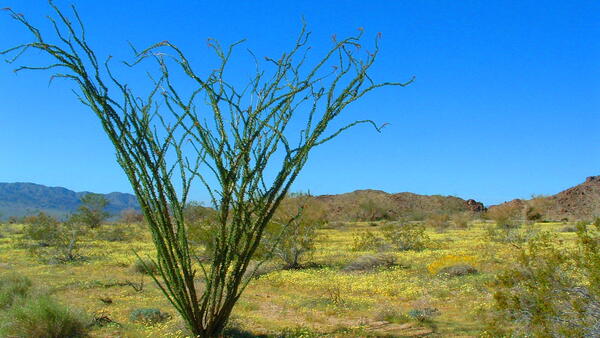How do seeds know when conditions are right?
“A flower blooming in the desert proves to the world that adversity, no matter how great, can be overcome.” ― Matshona Dhliwayo
By DR. CAMERON BARROWS
Hidden among the grains of desert sands are countless species of bacteria and fungi, minute fossorial arthropods, and the seeds of every kind of wildflower found in a given region. Those seeds are referred to as the seed bank, seeds waiting for just the right conditions to complete their life cycle, to sprout, grow, flower, get pollinated, form fruits and seeds, and then repopulate the seed bank. The key here is what are “just the right conditions” and how do those seeds “know” when the time and conditions are right? Naturalists hoping to answer that question, to then predict the composition and intensity of wildflower blooms in any given year, have mostly failed. As with most things in life and nature, it’s complicated.
Desert rain is fickle. A single storm is never a guarantee of sufficient soil moisture to allow seeds to complete their life cycle, no matter what month that rain falls. Imagine seeds waiting just below the desert surface in July. A monsoon storm would thoroughly soak the sand. However, seeds that germinated would then be faced with at least another three months of daytime temperatures well above the century level, and possibly not another drop of rain until December or later. Summer monsoons seem to be important for the germination of ocotillo and creosote. The success of their seedlings is then dependent on ample fall and winter rains. Being long-lived perennials, these species can afford to take chances, as there is always “next year.” Annual wildflowers don’t have that luxury. If their seeds germinated mid-summer they would almost certainly wilt and die without flowering, without producing seed. If all the wildflower seeds were to germinate in summer and then fail to produce seeds, there would be a regional extinction event, depopulating the seed bank and with little chance of it ever recovering. Even a single storm in December or January, if not followed by additional storms, could lead those seeds to the same dire end. Over the decades, centuries, and millennia of the existence of North American deserts there have been repeated instances of years with insufficient rainfall to allow seeds, once germinated, to complete their life cycle. Yet, desert wildflowers still carpet the desert floor when conditions are “just right.”
The answer to this conundrum has at least two components. First, every wildflower species has a specific “calculus” as to how much rain is necessary, and at what temperature and season, before germination occurs. Germinate at the wrong time, without sufficient rain, and those genes do not get passed along to future generations. I have lived in the Coachella Valley for almost 40 years, and over that time no two years have had identical patterns of rainfall, and no two years have had the identical composition and abundance of wildflowers. Each wildflower species responds differently to a given rainfall pattern. To be clear, in a year with abundant rain and lots of wildflowers, with enough searching you can likely find every possible wildflower species. However, the relative abundance of each species is what changes depending on specific rainfall, season, and temperature patterns. Some years, like in 2024, brown-eyed primroses and sand verbena are abundant and ubiquitous. Other years they are uncommon, but Fremont’s pincushions are abundant. Other years notched-leaved phacelia seems to take the spotlight. These different year, different relative abundances appear to be tied to responses to specific, perhaps subtle differences in rainfall conditions.
Using plant species occurrence and abundance data we collected on the Coachella Valley sand dunes over the past 20 years, a UC Riverside doctoral candidate, Clarissa Rodriguez, found that the occurrence of wildflower species was typically asynchronous, i.e. individual species responding independently, rather than synchronously, which would otherwise result in all species responding to given rainfall patterns the same way. She found that over that 20-year period we had recorded over 90 different plant species on the dunes. But, in any single year only a fraction of those 90+ species germinated. At least in part, it is the asynchronous responses to rainfall that contribute to the deceptively high biodiversity of our deserts.
Another part of the calculus for determining whether wildflowers germinate, bloom, and produce seeds is that only a fraction, say maybe 20-percent of a species’ seed bank might germinate in any given year, even under ideal conditions. Some seeds might sit in the seed bank for decades before taking their turn at germinating. Again, if every seed germinated at once, but then there was a deep frost, or intense heat, or the rainstorms suddenly stopped reaching the desert, then that species’ life cycle would be broken. That species would then be locally extinct, those genes would not contribute to future generations. So how then do individual seeds make a “choice” whether it is their turn to germinate? My guess is that there might be a chemical in the seed or seed coat that inhibits germination. Only after many years of rainfall events leaching away that inhibitor would the seeds then be able to germinate. A strong summer monsoon often brings on an impressive spring wildflower bloom. Perhaps the monsoon helps leach away potential germination inhibitors. Because of the unpredictability and variability of desert rain, those species that hedge their bets, with only a portion of their seed bank germinating in any given year, are ensuring at least some of their seeds will be able to complete their life cycle during the good years, and so safeguarding their long-term existence.
Nullius in verba – Go outside, tip your hat to a chuckwalla (and a cactus), and think like a mountain
